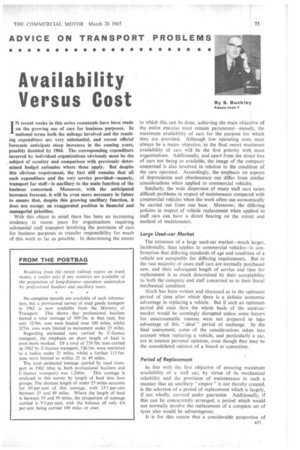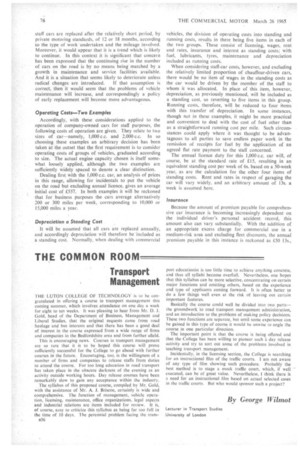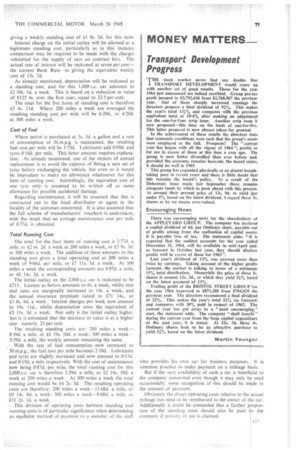Availability Versus Cost
Page 77

Page 78

Page 79

If you've noticed an error in this article please click here to report it so we can fix it.
IN recent weeks in this series comments have been made on the growing use of cars for business purposes. In national terms both the mileage involved and the resulting expenditure are very substantial, and recent official forecasts anticipate steep increases in the coming years, possibly doubled by 1984. The corresponding expenditure incurred by individual organizations obviously must be the subject of scrutiny and comparison with previously determined budget estimates where these apply. But despite this obvious requirement, the fact still remains that all such expenditure and the very service provided—namely, transport for staff—is ancillary to the main function of the business concerned. Moreover, with the anticipated increases forecast, it will be even more necessary in future to ensure that, despite this growing ancillary function, it does not occupy an exaggerated position in financial and managerial priorities.
With this object in mind there has been an increasing tendency in recent years for organizations requiring substantial staff transport involving the provision of cars for business purposes to transfer responsibility for much of this work as fat as possible. In determining the extent
to which this can be done, achieving the main objective of the entire exercise must remain paramount—namely, the maximum availability of cars for the purpose for which they are provided. Although low operating costs must always be a major objective, in the final resort maximum availability of cars will be the first priority with most organizations. Additionally, and apart from the direct loss of cars not being so available, the image of the company concerned is also involved in relation to the condition Of the cars operated. Accordingly, the emphasis on aspects of depreciation and obsolescence can differ from similar considerations when applied to commercial vehicles.
Similarly, the wide dispersion of many staff cars raises difficult problems in respect of maintenance compared with commercial vehicles when the work often can economically be carried out from one base. Moreover, the differing policies in respect of vehicle replacement when applied to staff cars can have a direct bearing on the extent and method of maintenance.
Large Used-car Market
The existence of a large used-car market—much larger, incidentally, than applies to commercial vehicles—is confirmation that differing standards of age and condition of a vehicle are acceptable for differing requirements. But in the vast majority of cases staff cars are normally purchased new, and their subsequent length of service and time for replacement is as much determined by their acceptability to both the company and staff concerned as to their literal mechanical condition.
Much has been written and discussed as to the optimum period of time after which there is a definite economic advantage in replacing a vehicle. But if such an optimum period did exist then the whole basis of the used-car market would be seemingly disrupted unless some buyers for unaccountable reasons were not prepared to take advantage of this " ideal " period of exchange. In the final assessment, some of the considerations taken into account when replacing a vehicle, and particularly a car, are in essence personal opinions, even though they may be the consolidated opinion of a board or committee.
Period of Replacement In line with the first objective of ensuring maximum availability of a staff car, by virtue of its mechanical reliability and the provision of maintenance in such a manner that an ancillary " empire " is not thereby created, is the selection of a period of replacement which is largely, if not wholly, covered under guarantee. Additionally, if this can be concurrently arranged, a period which would not normally involve the replacement of a complete set of tyres also would be advantageous.
It is for this reason that a considerable proportion of 035
staff cars are replaced after the relatively short period, by private motoring standards, of 12 or 18 months, according to the type of work -undertaken and the mileage involved. Moreover, it would appear that it is a trend which is likely to continue. In this context it is significant that concern has been expressed that the continuing rise in the number of cars on the road is by no means being matched by a growth in maintenance and service facilities available. And it is a situation that seems likely to deteriorate unless
radical changes are introduced. if that assumption is correct, then it would seem that the problems of vehicle maintenance will increase, and correspondingly a policy of early replacement will become more advantageous.
Operating Costs—Two Examples Accordingly, with these considerations applied to the operation of company-owned cars for staff purposes, the following costs of operation are given, They relate to two sizes of car—namely, 1,000 c.c. and 2,000 c.c. In so choosing these examples an arbitrary decision has been taken at the outset that the first requirement is to consider operating costs of groups of vehicles, graduated according to size. The actual engine capacity chosen is itself somewhat loosely applied, although the two examples are sufficiently widely spaced to denote a clear distinction.
Dealing first with the 1,000 c.c. car, an analysis of prices in this range, allowing for incidentals to put the vehicle on the road but excluding annual licence, gives an average initial cost of £557. In both examples it will be reckoned that for business purposes the cars average alternatively 200 or 300 miles per week, corresponding to 10,000 or 15,000 miles a year.
Depreciation a Standing Cost
It will be assumed that all cars are replaced annually, and accordingly depreciation will therefore be-included as a standing cost. Normally, when dealing with commercial
vehicles, the division of operating costs into standing and running costs, results in there being five items in each of the two groups. These consist of licensing, wages, rent and rates, insurance and interest as standing costs; with fuel, lubricants, tyres, maintenance and depreciation included as running costs.
When considering staff-car costs, however, and excluding the relatively limited proportion of chauffeur-driven cars, there would be no item of wages in the standing costs as the car would be driven by the member of the staff to whom it was allocated. In place of this item, however, depreciation, as previously mentioned, will be included as a standing cost, so reverting to five items in this group. Running costs, therefore, will be reduced to four kerns with this transfer of depreciation. In some instances, though not in these examples, it might be more practical and convenient to deal with the cost of fuel other than as a straightforward running cost per mile. Such circumstances could apply where it was thought to be advantageous to all parties to save endless paper work in the remission of receipts for fuel by the application of an agreed flat rate payment to the staff concerned.
The annual licence duty for this 1,000 c.c. car will, of course, be at the standard rate of £15, resulting in an equivalent standing cost per week of 6s. based on a 50-week year, as are the calculation for the other four items of standing costs. Rent and rates in respect of garaging the car will vary widely, and an arbitrary amount of 13s. a week is assumed here.
insurance Because the amount of premium payable for comprehensive car insurance is becoming increasingly dependent on the individual driver's personal aCcident record, this amount also can vary substantially. With the addition of an appropriate excess charge for commercial use in a medium-risk area and excluding fleet discounts, the annual premium payable in this instance is reckoned as £50 13s,,
giving a weekly standing cost of £1 Os. 3d. for this item.
Interest charge on the initial outlay will be allowed as a legitimate standing cost, particularly as in this instance comparison may be required to be made with the charges submitted for the supply of cars on contract hire. The actual rate of interest will be reckoned at seven per centthe current Bank Rate-so giving the equivalent weekly cost of 15s. 7d.
As already mentioned, depreciation will be reckoned as a standing cost, and for this 1,000 c.c. car amounts to £2 10s, id. a week. This is based on a reduction in value of £125 4s. over the first year, equal to 22.5 per cent.
The total for the five items of standing cost is therefore £5 4s. lid. Where 200 miles a week are averaged the resulting standing cost per mile will be 6.29d., or 4-20d. at 300 miles a week.
Cost of Fuel
Where petrol is purchased at 5s. 3d. a gallon and. a rate of consumption of 36 m.p.g. is maintained, the resulting fuel cost per mile will be 1•75d. Lubricants add 0-09d. and tyres 0.16d. per mile. This latter amount requires explanation. As already mentioned, one of the objects of annual replacement is to avoid the expense of fitting a new set of tyres before exchanging the vehicle, but even so it would be imprudent to make no allowance whatsoever for this item of running cost. Accordingly, the equivalent cost of one tyre only is assumed to be written off as some allowance for possible accidental damage.
Regarding maintenance, it will be assumed that this is contracted out to the local distributor or agent in the locality of the salesman concerned. It is also assumed that the full scheme of manufacturers' vouchers is undertaken, with the result that an average maintenance cost per mile of 0-77d. is obtained.
Total Running Cost
The total for the four items of running cost is 2.77d. a mile, or .f.2 6s. 2d. a week at 200 miles a week, or E3 9s. 3d. at 300 miles a week. The addition of these amounts to the standing cost gives a total operating cost at 200 miles a week of 9-06d, per mile, or £7 I ls. Id, a week. At 300 miles a week the corresponding amounts are 6.97d. a mile, or £8 14s. 2d. a week.
The initial outlay on the 2,000 c.c. car is reckoned to be £713. Licence as before amounts to 6s. a week, whilst rent and rates are marginally increased to 14s. a week, and the annual insurance premium raised to £71 14s., or Et 8s. 8d. a week. Interest charges per week now amount to 19s. I ld., whilst depreciation costs the equivalent of £3 Its. 3d. a week. Not only is the initial outlay higher, but it is estimated that the decrease in value is at a higher rate---namcly, 25 per cent.
The resulting standing costs are: 200 miles a week8-39d. a mile, or £6 19s. 10d. a week; 300 miles a week5-59d. a mile; the weekly amount remaining the same.
With the rate of fuel consumption now increased to 30 m.p.g., the fuel cost per mile becomes 2-10d. Lubricants and tyres are slightly increased and now amount to 0.13d. and 0.19d. a mile respectively. With the cost of maintenance now being 0.87d. per mile, the total running cost for this 2,000 c.c. car is therefore 3'29d. a mile, or £2 14s. 10d. a week at 200 miles a week. At 300 miles a week the total running cost would be £4 2s. 3d. The resulting operating costs are therefore: 200 miles a week-I I-68d. a mile, or £9 14s. 8d. a week; 300 miles a week-8-88d. a mile, or £11 2s id. a week.
This division of operating costs between standing and running costs is of particular significance when determining an equitable method of payment to a member of the staff
who provides ha own car for business purposes. It is common practice to make payment on a mileage basis.
But if the very availability of such a car is beneficial to the company concerned even though it may only be used occasionally, some recognition of this should be made in the amount of payment.
Obviously the direct operating costs relative to the actual mileage run need to be reimbursed to the owner of the car. Additionally it could be contended that a further proportion of the standing costs should also be paid y the company if priority of use is claimed.




























































































































